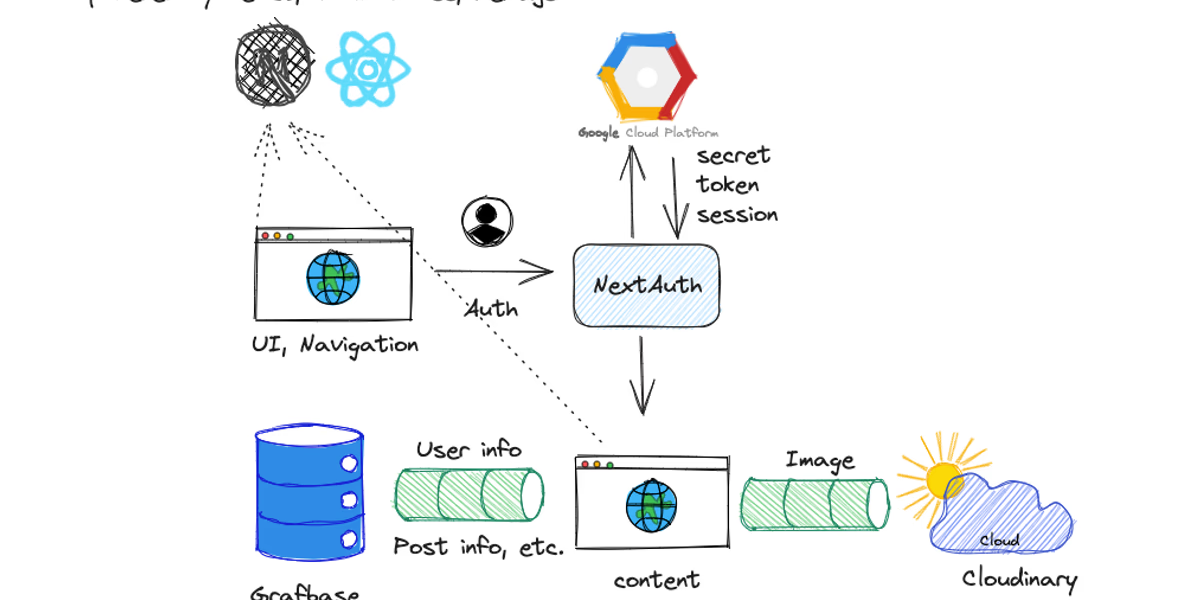Fullstack Project using Next.js, Graphql and Nextauth
Project Resource
Build and Deploy a Full Stack Next.js 13 Application | React, Next JS 13, TypeScript, Tailwind CSS
By JavaScript Mastery
Youtube Video Link:https://www.youtube.com/watch?v=986hztrfaSQ
Thanks for amazing tutorial :)
Technical Stack
- Frontend: React, tailwindcss
- Authentication: NextAuth
- Data storage: grafbase
- Image storage: cloudinary
Main Module
- Frontend UI(components)
- Authentication(api/auth, lib/session.ts)
- Data storage(grafbase,graphql,lib/action.ts,api/cloudinary)
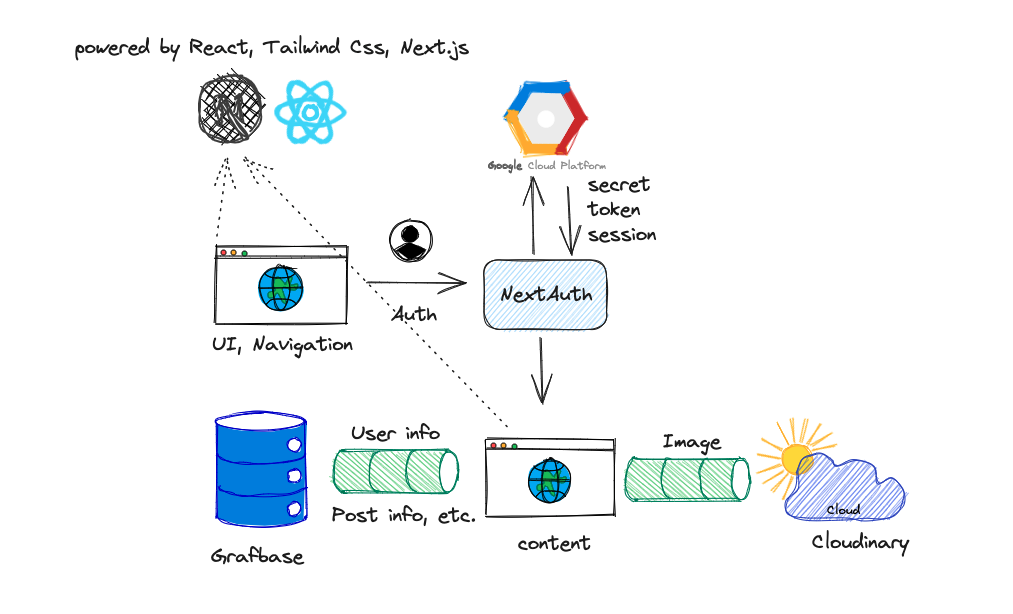
Frontend UI
Tech Stack: NextAuth, GCP, Nextjs API
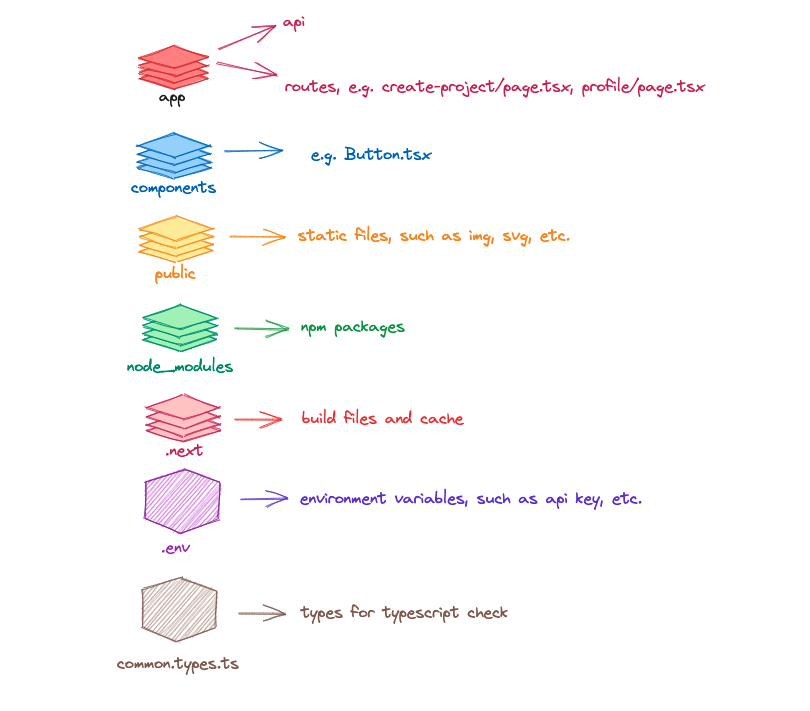
- app: contains api and frontend route
- app/api: next api, can be called while app is running, in this project used as auth and image upload.
- app/route/page.tsx: nextjs routing system, each page is a route, could be accessed by /route
- components: reusable components, such as button, navigation bar, etc.
- public: static resources, such as img, svg icon, etc. can be accessed by / from anywhere in the project
- node modules: npm package storage
- .next: store build files and cache
- .env: environment variables
- common.types.ts: export types for typescript check
Authentication
Tech Stack: NextAuth, GCP
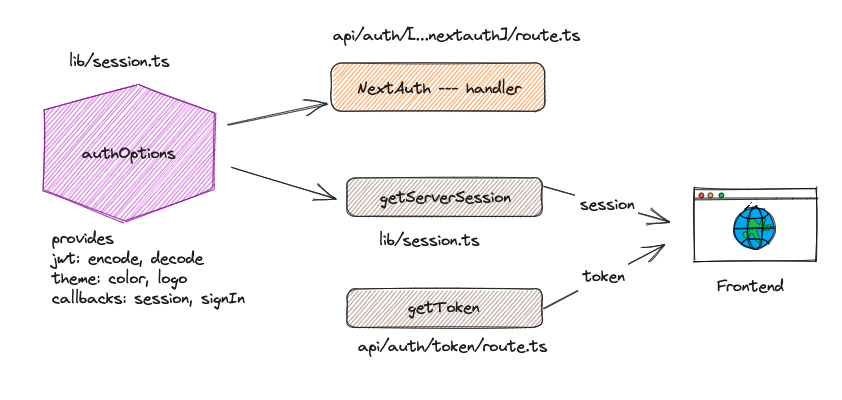
/lib/seesion.ts
init authOptions and getServerSession
import { getServerSession } from "next-auth";
import { NextAuthOptions,User } from "next-auth";
import { AdapterUser } from "next-auth/adapters";
import GoogleProvider from 'next-auth/providers/google'
import jsonwebtoken from 'jsonwebtoken'
import { JWT } from "next-auth/jwt";
import { SessionInterface, UserProfile } from "@/common.types";
import { createUser, getUser } from "./actions";
export const authOptions: NextAuthOptions = {
providers: [
GoogleProvider({
clientId: process.env.GOOGLE_CLIENT_ID!,
clientSecret:process.env.GOOGLE_CLIENT_SECRET!
})
],
jwt:{
encode:({secret, token})=>{
const encodedToken = jsonwebtoken.sign({
...token,
iss:'grafbase',
exp: Math.floor(Date.now()/1000) + 60 * 60
}, secret)
return encodedToken
},
decode: async ({secret, token})=>{
const decodedToken = jsonwebtoken.verify(token!, secret) as JWT
return decodedToken
}
},
theme:{
colorScheme:'light',
logo:'./logo.png'
},
callbacks:{
async session({session}) {
const email = session?.user?.email as string
try {
const data = await getUser(email) as {user?: UserProfile}
const newSession = {
...session,
user: {
...session.user,
...data?.user
}
}
return newSession
} catch(error) {
console.log('Error retrieving user data',error)
return session
}
},
async signIn({user}: {user: AdapterUser | User}){
try{
//get the user if they exist
const userExists = await getUser(user?.email as string) as {user?: UserProfile}
// if they do not exist, create them
if(!userExists.user) {
await createUser(
user.name as string,
user.email as string,
user.image as string
)
}
return true
} catch (error: any) {
console.log(error)
return false
}
}
}
}
export async function getCurrentUser() {
const session = await getServerSession(authOptions) as SessionInterface
return session
}/app/api/auth/[…nextauth]/route.ts
use authOptions, generate auth handler
import NextAuth from "next-auth/next";
import { authOptions } from "@/lib/session";
const handler = NextAuth(authOptions)
export {handler as GET, handler as POST}/app/api/auth/token/route.ts
return token
import { getToken } from "next-auth/jwt";
import { NextRequest, NextResponse } from "next/server";
const secret = process.env.NEXTAUTH_SECRET
export async function GET(req: NextRequest) {
const token = await getToken({req, secret, raw: true})
return NextResponse.json({token},{status:200})
}
/app/page.tsx
signIn page
"use client";
import { useState,useEffect } from "react";
import {getProviders, signIn} from 'next-auth/react'
import Button from "./Button";
type Provider = {
id: string;
name: string;
type: string;
signinUrl: string;
callbackUrl: string;
signinUrlParams?: Record<string, string> | undefined;
};
type Providers = Record<string, Provider>;
const AuthProviders = () => {
const [providers, setProviders] = useState<Providers | null>(null)
useEffect(()=>{
const fetchProviders = async ()=>{
const res = await getProviders();
setProviders(res);
console.log(res)
}
fetchProviders()
},[])
if(providers){
return (
<div>
{Object.values(providers).map(
(provider: Provider, i)=> (
<Button key={i} title="Sign In" handleClick={()=>signIn(provider?.id)} />
)
)}
</div>
)
}
}
export default AuthProvidersImage Storage
Tech Stack: Cloudinary, Nextjs API
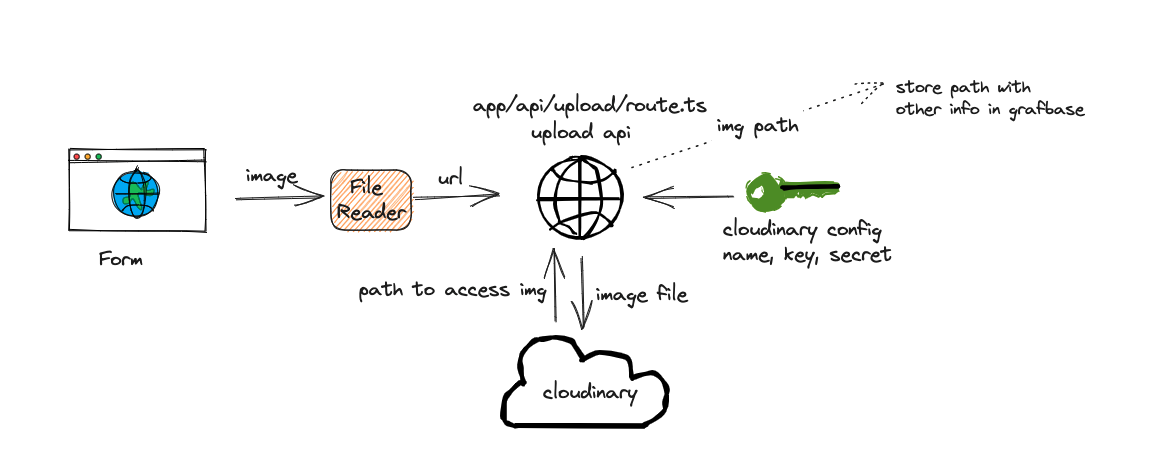
/app/api/upload/route.ts
import { NextResponse } from "next/server"
import {v2 as cloudinary} from 'cloudinary'
cloudinary.config({
cloud_name: process.env.CLOUDINARY_NAME,
api_key: process.env.CLOUDINARY_KEY,
api_secret: process.env.CLOUDINARY_SECRET
});
export async function POST(request:Request) {
const {path} = await request.json()
if(!path){
return NextResponse.json(
{message: "Image path is required"},
{status: 400}
)
}
try {
const options = {
use_filename: true,
unique_filename: false,
overwrite: true,
transformation: [{width: 1000, height: 752, crop:'scale'}]
}
const result = await cloudinary.uploader.upload(path,options)
return NextResponse.json(result,{status:200})
} catch (error) {
return NextResponse.json(
{message: error},
{status: 500}
)
}
}/components/ProjectForm.tsx(only image related part)
"use client"
import { ProjectInterface, SessionInterface } from "@/common.types"
import { ChangeEvent, useState } from "react"
import Image from "next/image"
import FormField from "./FormField"
import { categoryFilters } from "@/constants"
import CustomMenu from "./CustomMenu"
import Button from "./Button"
import { createNewProject, fetchToken, updateProject } from "@/lib/actions"
import { useRouter } from "next/navigation"
type Props = {
type: string,
session: SessionInterface,
project?: ProjectInterface
}
const ProjectForm = ( {type, session, project}: Props ) => {
const router = useRouter()
const handleFormSubmit = async (e: React.FormEvent) => {
e.preventDefault()
setIsSubmitting(true)
const {token} = await fetchToken()
try {
if(type==='create'){
// create new project
await createNewProject(form, session?.user?.id, token)
router.push('/')
}
if(type === 'edit'){
await updateProject(form, project?.id as string, token)
router.push('/')
}
} catch (error) {
console.log(error)
} finally {
setIsSubmitting(false)
}
}
const handleChangeImage = (e: ChangeEvent<HTMLInputElement>) => {
e.preventDefault()
const file = e.target.files?.[0]
if(!file) return
if(!file.type.includes('image')) {
return alert("Please upload an image file")
}
const reader = new FileReader()
reader.readAsDataURL(file)
reader.onload = ()=>{
const result = reader.result as string
handleStateChange('image',result)
}
}
return (
<form onSubmit={handleFormSubmit} className="flexStart form">
<label htmlFor="poster" className="flexCenter form_image-label">
{!form.image && 'Choose a poster for your project'}
</label>
<input id="image" type="file" accept="image/*" required={type==='create'} className="form_image-input" onChange={handleChangeImage}/>
{form.image && (
<Image src={form?.image} className="sm:p-10 object-contain z-20" alt="Project poster" fill/>
)}
</div>
<div className="flexStart w-full">
<Button
title={isSubmitting ? `${type==='create'?'Creating':'Editing'}`
:`${type==='create'?'Create':'Edit'}`}
type="submit" leftIcon={isSubmitting?"":"/plus.svg"} submitting={isSubmitting}
/>
</div>
</form>
)
}
export default ProjectForm/lib/action.ts/uploadImage
export const uploadImage = async (imagePath: string) => {
try {
const response = await fetch(`${serverUrl}/api/upload`,{
method: 'POST',
body: JSON.stringify({path: imagePath})
})
return response.json()
} catch (error) {
throw error
}
}Data Storage (Graphql)
Tech Stack: Grafbase, graphql-request
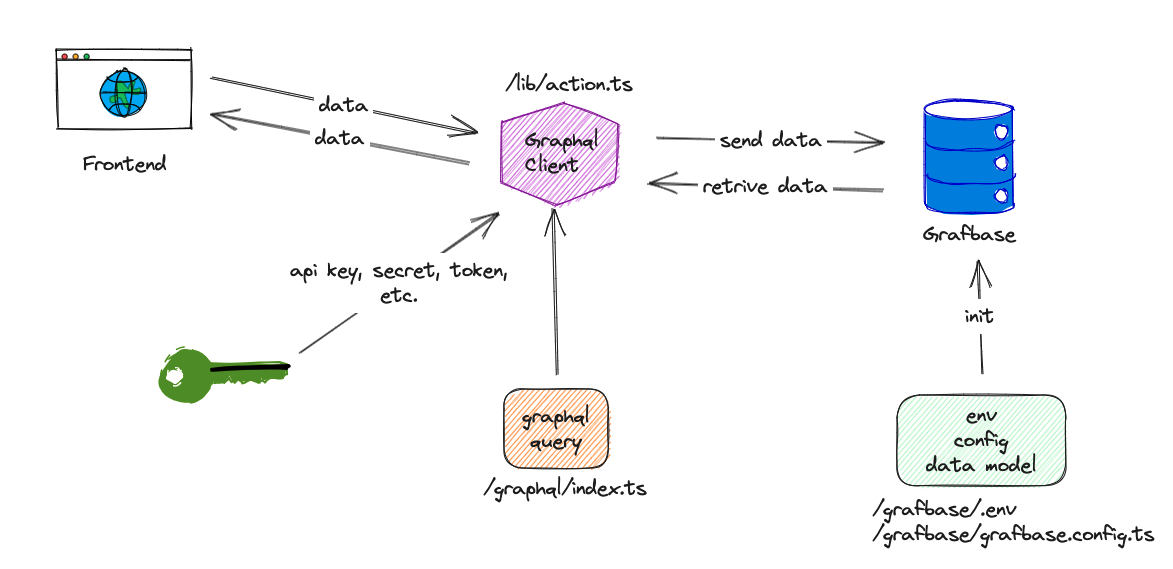
-
Graphql Client
make graphql query, connect grafbase
/lib/action.ts
import { ProjectForm } from "@/common.types";
import { allProjectsQuery, createProjectMutation, createUserMutation, deleteProjectMutation, getProjectByIdQuery, getProjectsOfUserQuery, getUserQuery, projectsQuery, updateProjectMutation } from "@/graphql";
import { GraphQLClient } from "graphql-request";
const isProduction = process.env.NODE_ENV === 'production';
const apiUrl = isProduction ? process.env.NEXT_PUBLIC_GRAFBASE_API_URL || '' : 'http://127.0.0.1:4000/graphql'
const apiKey = isProduction ? process.env.NEXT_PUBLIC_GRAFBASE_API_KEY || '' : 'letmein'
const serverUrl = isProduction ? process.env.NEXT_PUBLIC_SERVER_URL : 'http://localhost:3000'
const client = new GraphQLClient(apiUrl)
const makeGraphQLRequest = async (query: string, variables={}) => {
try{
//client request....
return await client.request(query, variables)
} catch (error) {
throw error
}
}
export const getUser = (email: string) => {
client.setHeader('x-api-key',apiKey)
return makeGraphQLRequest(getUserQuery,{email})
}
export const createUser = (name: string, email: string, avatarUrl: string) => {
client.setHeader('x-api-key',apiKey)
const variables = {
input: {
name, email, avatarUrl
}
}
return makeGraphQLRequest(createUserMutation, variables)
}
export const fetchToken = async ()=> {
try {
const response = await fetch(`${serverUrl}/api/auth/token`)
return response.json()
} catch(error) {
throw error
}
}
export const uploadImage = async (imagePath: string) => {
try {
const response = await fetch(`${serverUrl}/api/upload`,{
method: 'POST',
body: JSON.stringify({path: imagePath})
})
return response.json()
} catch (error) {
throw error
}
}
export const createNewProject = async (form: ProjectForm, creatorId: string, token: string) => {
const imageUrl = await uploadImage(form.image)
if(imageUrl.url) {
client.setHeader("Authorization",`Bearer ${token}`)
const variables = {
input: {
...form,
image: imageUrl.url,
createdBy: {
link: creatorId
}
}
}
return makeGraphQLRequest(createProjectMutation, variables)
}
}
export const fetchAllProjects = (category?: string | null, endcursor?: string | null) => {
client.setHeader("x-api-key", apiKey);
if(!category){
return makeGraphQLRequest(allProjectsQuery)
} else{
return makeGraphQLRequest(projectsQuery,{category,endcursor});
}
};
export const getProjectDetails = (id:string) => {
client.setHeader('x-api-key',apiKey)
return makeGraphQLRequest(getProjectByIdQuery,{id})
}
export const getUserProjects = (id:string, last?: number) => {
client.setHeader('x-api-key',apiKey)
return makeGraphQLRequest(getProjectsOfUserQuery,{id, last})
}
export const deleteProject = (id:string, token: string) => {
client.setHeader("Authorization",`Bearer ${token}`)
return makeGraphQLRequest(deleteProjectMutation,{id})
}
export const updateProject = async (form: ProjectForm, projectId:string, token: string) => {
function isBase64DataURL(value: string) {
const base64Regex = /^data:image\/[a-z]+;base64,/;
return base64Regex.test(value);
}
let updatedForm = {...form}
const isUploadingNewImage = isBase64DataURL(form.image)
if(isUploadingNewImage) {
const imageUrl = await uploadImage(form.image)
if(imageUrl.url) {
updatedForm = {
...form,
image: imageUrl.url
}
}
}
const variables = {
id: projectId,
input: updatedForm
}
client.setHeader("Authorization",`Bearer ${token}`)
return makeGraphQLRequest(updateProjectMutation,variables)
}
-
graphql query
store graphql query
/graphql/index.ts
export const createProjectMutation = `
mutation CreateProject($input: ProjectCreateInput!) {
projectCreate(input: $input) {
project {
id
title
description
createdBy {
email
name
}
}
}
}
`;
export const updateProjectMutation = `
mutation UpdateProject($id: ID!, $input: ProjectUpdateInput!) {
projectUpdate(by: { id: $id }, input: $input) {
project {
id
title
description
createdBy {
email
name
}
}
}
}
`;
export const deleteProjectMutation = `
mutation DeleteProject($id: ID!) {
projectDelete(by: { id: $id }) {
deletedId
}
}
`;
export const createUserMutation = `
mutation CreateUser($input: UserCreateInput!) {
userCreate(input: $input) {
user {
name
email
avatarUrl
description
githubUrl
linkedInUrl
id
}
}
}
`;
export const allProjectsQuery = `
query getProjects {
projectSearch(first: 1) {
pageInfo {
hasNextPage
hasPreviousPage
startCursor
endCursor
}
edges {
node {
title
githubUrl
description
liveSiteUrl
id
image
category
createdBy {
id
email
name
avatarUrl
}
}
}
}
}
`;
export const projectsQuery = `
query getProjects($category: String, $endcursor: String) {
projectSearch(first: 8, after: $endcursor, filter: {category: {eq: $category}}) {
pageInfo {
hasNextPage
hasPreviousPage
startCursor
endCursor
}
edges {
node {
title
githubUrl
description
liveSiteUrl
id
image
category
createdBy {
id
email
name
avatarUrl
}
}
}
}
}
`;
export const getProjectByIdQuery = `
query GetProjectById($id: ID!) {
project(by: { id: $id }) {
id
title
description
image
liveSiteUrl
githubUrl
category
createdBy {
id
name
email
avatarUrl
}
}
}
`;
export const getUserQuery = `
query GetUser($email: String!) {
user(by: { email: $email }) {
id
name
email
avatarUrl
description
githubUrl
linkedInUrl
}
}
`;
export const getProjectsOfUserQuery = `
query getUserProjects($id: ID!, $last: Int = 4) {
user(by: { id: $id }) {
id
name
email
description
avatarUrl
githubUrl
linkedInUrl
projects(last: $last) {
edges {
node {
id
title
image
}
}
}
}
}
`;-
grafbase
init grafbase and data model
/grafbase/grafbase.config.ts
import { g, auth, config } from '@grafbase/sdk'
// Welcome to Grafbase!
// Define your data models, integrate auth, permission rules, custom resolvers, search, and more with Grafbase.
// Integrate Auth
// https://grafbase.com/docs/auth
//
// const authProvider = auth.OpenIDConnect({
// issuer: process.env.ISSUER_URL ?? ''
// })
//
// Define Data Models
// https://grafbase.com/docs/database
// @ts-ignore
const User = g.model('User',{
name: g.string().length({ min: 2, max: 20}),
email: g.string().unique(),
avatarUrl: g.url(),
description: g.string().optional(),
githubUrl: g.url().optional(),
linkedInUrl: g.url().optional(),
projects: g.relation(()=>Project).list().optional(),
}).auth((rules)=>{
rules.public().read()
})
// @ts-ignore
const Project = g.model('Project',{
title: g.string().length({min:3}),
description: g.string(),
image: g.url(),
liveSiteUrl:g.url(),
githubUrl: g.url(),
category: g.string().search(),
createdBy: g.relation(()=>User)
}).auth((rules)=>{
rules.public().read(),
rules.private().create().delete().update();
})
const jwt = auth.JWT({
issuer: 'grafbase',
secret: g.env('NEXTAUTH_SECRET')
})
export default config({
schema: g,
// Integrate Auth
// https://grafbase.com/docs/auth
auth: {
providers: [jwt],
rules: (rules) => {
rules.private()
}
}
})
/grafbase/.env
# KEY=VALUE
NEXTAUTH_SECRET = abcAn example for data fetch at frontend
/app/page.tsx
const Home = async ({searchParams: {category, endCursor}}: Props) => {
const data = await fetchAllProjects(category,endCursor) as ProjectSearch
const projectsToDisplay = data?.projectSearch?.edges || []
return (
<div>
{projectsToDisplay}
</div>
)
}
// submit and store a new project(need token)
const handleFormSubmit = async (e: React.FormEvent) => {
e.preventDefault()
setIsSubmitting(true)
const {token} = await fetchToken()
try {
if(type==='create'){
// create new project
await createNewProject(form, session?.user?.id, token)
router.push('/')
}
if(type === 'edit'){
await updateProject(form, project?.id as string, token)
router.push('/')
}
} catch (error) {
console.log(error)
} finally {
setIsSubmitting(false)
}
}